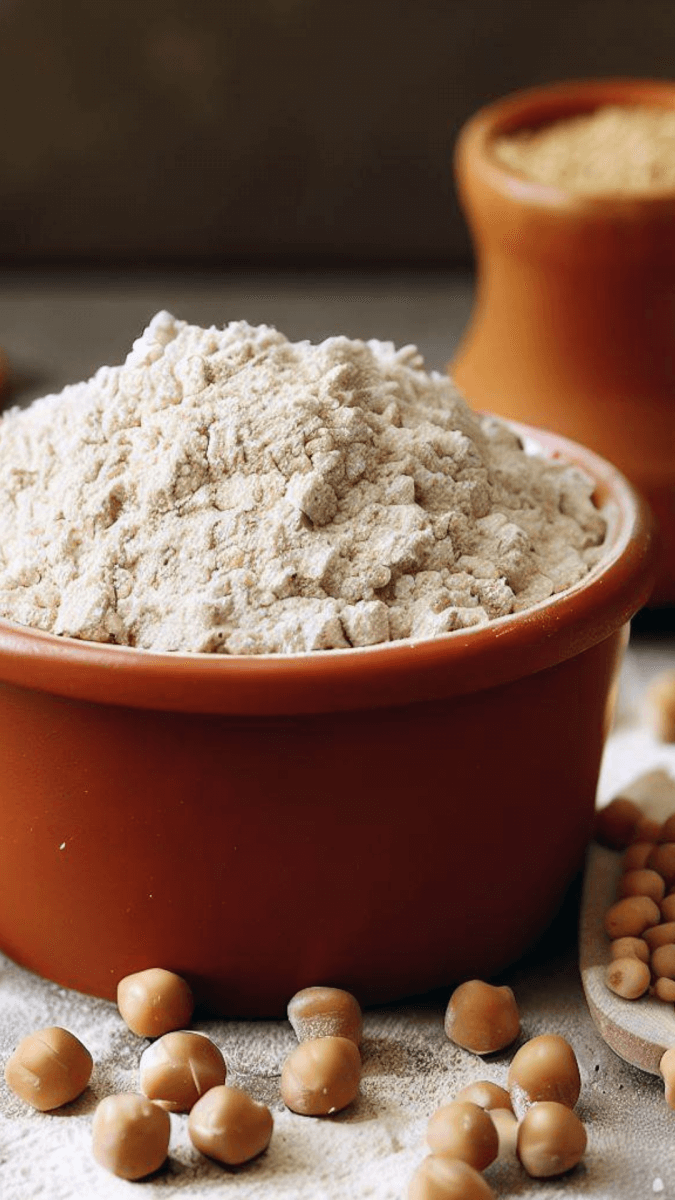Are you looking for a substitute for Sorghum Flour? Try using tapioca flour, rice flour, almond flour, chickpea flour, coconut flour, or buckwheat flour. Let’s look at these in a bit more detail.
What is Sorghum Flour?
If you are into gluten-free baking you will probably already know about Sorghum Flour. It is a type of flour made from ground sorghum grains. Sorghum is actually a cereal grain that belongs to the grass family and is widely cultivated for its edible seeds. It is a very versatile crop and is used for various purposes, including human consumption, animal feed, and ethanol production.
Sorghum flour is typically produced by milling the whole sorghum grains into a fine powder. It has a light color and a slightly sweet and nutty flavor. Sorghum flour is naturally gluten-free, making it an excellent alternative for individuals who have gluten intolerance or celiac disease.
This flour is commonly used in gluten-free baking and cooking. It can be used as a standalone flour or combined with other gluten-free flours to create a blend for baking bread, muffins, cakes, cookies, and other baked goods. It can also be used as a thickener in soups, sauces, and gravies.
Sorghum flour is known for its nutritional benefits. It is a good source of dietary fiber, protein, and various essential minerals such as iron, phosphorus, and potassium. It also contains antioxidants and other beneficial compounds that may have health-promoting properties.
The only trouble with sorghum flour is that it can be quite difficult to find, hence I came up with the following list of substitutes. I hope this helps.
Okay, before we look at your Sorghum Flour substitute options, let’s deal with that empty cupboard situation!
Where can I buy Sorghum Flour?
If you want to be more prepared and ensure you don’t run out of Sorghum Flour then you should stock up now.
It can be quite difficult to find stockists of Sorghum Flour but we have found one on-line which might help you. Here is a link for a large 2lb bag of Sorghum Flour.
So why not jump on and place your order today.
STOCK UP NOW!
100% Organic Sorghum Flour.
Sustainably sourced, all natural and batch tested, ensuring you receive the perfect product
Great for gluten free baking.
Large 2lb bag.
What can I substitute for Sorghum Flour?
Here are some of the best ingredients to substitute the flavor and role that Sorghum Flour provides in your recipes.
- Tapioca flour
- Almond flour
- Rice flour
- Buckwheat flour
- Chickpea flour
- Coconut flour
Sorghum Flour substitutes
Tapioca Flour
Tapioca flour can be used as a substitute for sorghum flour in some recipes, but it’s important to note that the two flours have different properties, so the results may vary.
It is also known as tapioca starch, and is derived from the cassava root. It is a fine, white flour that is often used as a thickening agent in cooking and baking. Tapioca flour is gluten-free and has a neutral taste which makes it suitable for mixing with other ingredients.
When substituting tapioca flour for sorghum flour, it’s important to consider the differences in their texture and binding properties. Sorghum flour has a slightly grainy texture and provides structure to baked goods, while tapioca flour is smoother and has a more gel-like consistency when mixed with liquids.
If you’re using tapioca flour as a substitute for sorghum flour in a recipe, here are some general guidelines:
- Use a 1:1 substitution ratio: Replace sorghum flour with an equal amount of tapioca flour. For example, if a recipe calls for 1 cup of sorghum flour, use 1 cup of tapioca flour instead.
- Adjust the liquid content: Tapioca flour has a higher starch content than sorghum flour, which means it can absorb more liquid. You may need to reduce the amount of liquid in the recipe or increase the amount of tapioca flour slightly to achieve the desired consistency.
- Combine with other flours: Tapioca flour alone may not provide the same structure and flavor as sorghum flour. Consider using a combination of tapioca flour with other gluten-free flours, such as rice flour, almond flour, or coconut flour, to enhance the texture and taste of the final product.
It’s important to note that tapioca flour does not have the same nutritional profile as sorghum flour, so the substitution may impact the overall nutritional content of your recipe.

Almond Flour
Almond flour can be used as a substitute for sorghum flour in certain recipes, especially if you’re looking for a gluten-free alternative. However, it’s important to consider the differences in their properties when making the substitution.
Almond flour is made from finely ground blanched almonds, and it has a slightly sweet and nutty flavor. It is commonly used in gluten-free and grain-free baking. Almond flour is rich in healthy fats, protein, and dietary fiber, making it a nutritious choice.
Almond flour is typically denser and moister than sorghum flour, which can affect the texture and structure of your baked goods. You might need to make adjustments to compensate for this. For recipes that require a light and fluffy texture, almond flour may not be the best choice as a 1:1 substitute.
Sorghum flour provides some binding and leavening properties due to its starch content. Almond flour, on the other hand, does not have the same binding properties and may require additional ingredients like eggs or binders such as xanthan gum or guar gum to help with structure.
Almond flour has a distinct nutty flavor that can alter the taste of the final product. This can work well in recipes like cookies, cakes, and muffins that pair well with the almond flavor. However, it may not be suitable for recipes that require a neutral taste.
When substituting almond flour for sorghum flour, you may need to experiment and adjust the recipe to achieve the desired results. It’s often helpful to combine almond flour with other gluten-free flours, such as tapioca flour or rice flour, to improve the texture and provide better structure.
Remember that almond flour is not a 1:1 substitute for sorghum flour, so it’s essential to consider the specific recipe and make modifications accordingly.

Rice Flour
Rice flour can be a suitable substitute for sorghum flour in many recipes, particularly in gluten-free baking. It is made by finely grinding rice grains into a fine powder, and it is commonly used in various cuisines around the world.
Rice flour tends to have a smoother and lighter texture compared to sorghum flour. This can result in a lighter and more delicate final product. If you’re aiming for a denser texture, you may need to combine rice flour with other flours or add additional binding agents like xanthan gum.
Rice flour may have different absorption properties compared to sorghum flour. It may absorb more or less liquid, so it’s important to monitor the consistency of the batter or dough when substituting. Adjustments to the liquid content may be necessary.
Rice flour has a mild and slightly sweet flavor, which is generally neutral and doesn’t overpower other ingredients. However, it lacks the slight nutty flavor that sorghum flour possesses. Depending on the recipe, this flavor difference may or may not be noticeable.
When substituting rice flour for sorghum flour, you can generally use a 1:1 ratio. However, it’s advisable to mix rice flour with other gluten-free flours, such as tapioca flour or potato starch, to achieve better texture and consistency in your baked goods.

Buckwheat Flour
Buckwheat flour can be a suitable substitute for sorghum flour in certain recipes, particularly for those looking for a gluten-free alternative. It is actually not related to wheat and is naturally gluten-free.
Buckwheat flour has a distinct earthy and nutty flavor, which can add a unique taste to your recipes. Depending on the recipe, this flavor profile can be desirable or may need to be balanced with other ingredients.
Buckwheat flour has a slightly denser texture compared to sorghum flour. It can contribute to a heartier and more substantial texture in baked goods. It is important to note that buckwheat flour has a higher protein content, which can affect the overall structure of the final product. You may need to adjust the liquid and binding ingredients accordingly.
Buckwheat flour has a darker color compared to sorghum flour, which can impact the appearance of your baked goods. If the recipe relies on a lighter color, it may not be the best substitute visually.
When using buckwheat flour as a substitute, you can generally use a 1:1 ratio. However, it is recommended to combine it with other gluten-free flours, such as rice flour or tapioca flour, to achieve better texture and balance the flavor.

Chickpea Flour
Chickpea flour, also known as gram flour or besan, can be a suitable substitute for sorghum flour in many recipes, especially in gluten-free and grain-free cooking. It is made by grinding dried chickpeas into a fine powder and is commonly used in various cuisines, particularly in Indian, Middle Eastern, and Mediterranean dishes.
It has a distinctive nutty and slightly earthy flavor. This flavor profile can add a unique taste to your recipes, which may work well in certain dishes. However, it’s important to note that the flavor of chickpea flour is more pronounced compared to sorghum flour. Depending on the recipe, this flavor difference may or may not be desirable.
Chickpea flour has a slightly denser texture compared to sorghum flour. It has good binding properties, which can contribute to the structure and texture of baked goods. However, chickpea flour tends to be heavier, and the final product may be denser than when using sorghum flour. Adding some leavening agents like baking powder or baking soda can help offset this density.
Chickpea flour has a yellowish color, which can impact the appearance of your baked goods. This color may work well in certain recipes but may not be desired in others. If color is important, consider this aspect when substituting.
When using chickpea flour as a substitute for sorghum flour, you can generally use a 1:1 ratio. However, keep in mind the differences in flavor and texture. It’s often beneficial to combine chickpea flour with other gluten-free flours, such as rice flour or tapioca flour, to achieve a better texture and balance the flavor.

Coconut Flour
Coconut flour can be used as a substitute for sorghum flour in some recipes, particularly in gluten-free and grain-free baking.
You should note that coconut flour has a high absorption rate compared to sorghum flour. Therefore it requires a significant amount of liquid to prevent the final product from becoming dry and dense. If you’re substituting coconut flour for sorghum flour, you’ll likely need to increase the liquid content in the recipe or use more eggs or other binding agents.
Coconut flour has a unique texture that is quite different from sorghum flour. It is very absorbent and can result in a denser and drier texture if not properly adjusted. Some recipes may work well with this texture, particularly if you’re aiming for a more crumbly or dense result.
Coconut flour has a distinct coconut flavor, which can significantly impact the taste of the final dish. This flavor can work well in certain recipes, such as coconut-flavored desserts or savory dishes that complement the coconut taste. However, it may not be suitable for all recipes, particularly those that require a neutral or different flavor profile.
When substituting coconut flour for sorghum flour, it’s important to note that coconut flour is not a direct 1:1 substitution due to its high absorbency. Therefore, I would suggest using only a fraction of the amount of coconut flour compared to sorghum flour, usually around 1/4 to 1/3 of the quantity.
Due to the unique properties of coconut flour, it’s often recommended to use a combination of flours when substituting. Combining coconut flour with other gluten-free flours, such as almond flour or tapioca flour, can help achieve a better texture and balance in the final result.

Summary for Sorghum Flour substitutes
Okay – that’s you all sorted with suitable substitutes for Sorghum Flour.
I hope you find the list of suggested alternatives helpful when you are looking for an substitute for Sorghum Flour.
- Tapioca flour can be used as a substitute for sorghum flour in gluten-free recipes. Use a 1:1 ratio, adjust liquid content if needed, and consider combining with other gluten-free flours for optimal texture.
- Almond flour can be used as a substitute, but it has a different texture and flavor. Adjustments may be needed for binding and leavening. Combine with other flours for better results.
- Rice flour is a suitable substitute for sorghum flour. Use a 1:1 ratio, consider adjustments for texture and absorption, and combine with other gluten-free flours if desired.
- Buckwheat flour can be used as a substitute, but it has a distinct flavor and denser texture. Adjustments may be needed for flavor balance and structure. Combine with other flours for better results.
- Chickpea flour can be used as a substitute for sorghum flour. Use a 1:1 ratio, consider adjustments for flavor and texture, and combine with other flours for optimal results.
- Coconut flour can be used as a substitute, but it has high absorption and a distinct flavor. Use a fraction of the amount compared to sorghum flour, adjust liquid content significantly, and consider combining with other flours for texture and flavor balance.
If you would like to learn about other ingredients you can swap out, why not head over to our Substitutes section?

